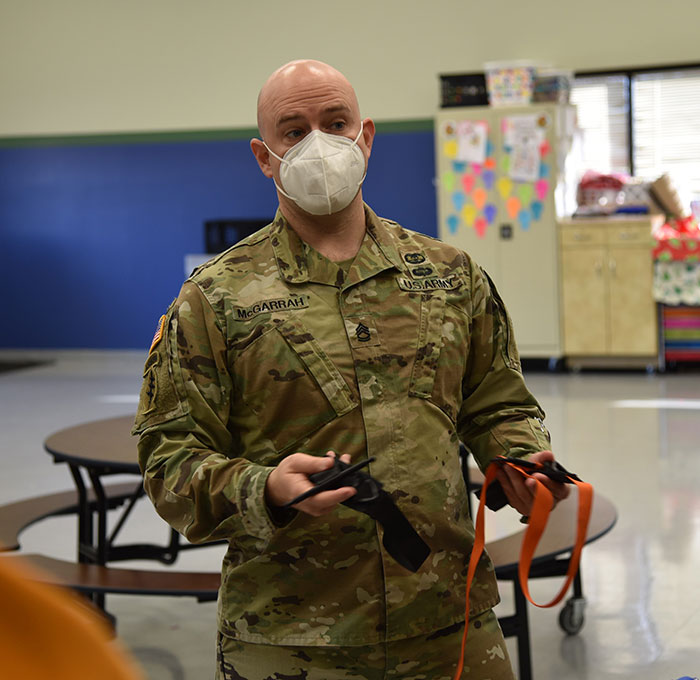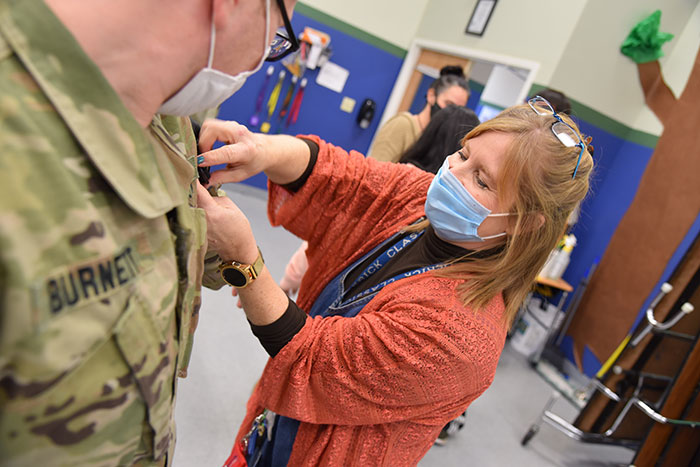USAMRDC Trains Local Teachers to 'Stop the Bleed'

Soldiers from the U.S. Army Medical Research and Development Command organized a "Stop the Bleed" training class for teachers at the Frederick Classical Charter School on December 16. The event, led by Sgt. 1st Class Dan McGarrah, Senior Enlisted Leader at USAMRDC's U.S. Army Medical Material Development Activity, comes as part of the command's enduring commitment to teaching the surrounding community and the public at-large on the proper ways to respond to traumatic bleeding events.
"They need to be comfortable with these skills," said McGarrah, a medic by trade who peppered his presentation with stories gleaned from his six deployments and the more than one thousand patients he's treated for trauma. "These teachers need to know how to save these specific lives – the lives of small children."
To that end, McGarrah tailored his nearly two-hour presentation to focus on information the attendees – which included members of school's leadership staff – would likely find most important in their daily professional lives. To wit, McGarrah spent time explaining the differences between the so-called "three types of bleeding" (e.g. arterial, venous and capillary), as well as how to calm and care for smaller patients in a trauma setting. Following a brief lecture to open the event, McGarrah then led the group in an extended hands-on demonstration of proper tourniquet use.
"We have a crisis plan, certainly, but I didn't feel our training went deep enough to be prepared," said FCCS Assistant Principal Dawn Getzandanner, noting that the sheer size of the school's student body – which sits at nearly 700 – demands an acute level of awareness. "Any time you go through a training exercise like this one you increase your familiarity and comfort level."

The "Stop the Bleed" campaign itself was developed chiefly at USAMRDC's Combat Casualty Care Research Program and later officially launched by the White House in October 2015. Developed in the wake of then-recent mass trauma events like the Sandy Hook Elementary School shooting (2012) and the Boston Marathon bombing (2013), the campaign is designed to encourage regular American citizens to both recognize and stop traumatic bleeding in everyday situations. A key part of the campaign is translating the usage of tourniquets – which the U.S. military used to an increasing and successful degree during recent operations in Iraq and Afghanistan – into American civilian life when necessary. The campaign currently has hundreds of licensed affiliates across the U.S. and is further licensed in more than half-a-dozen countries across the globe.
Among the key takeaways from the event at FCCS, McGarrah asserted the importance of timeliness in addressing incidents of hemorrhage, noting that upwards of 60% of all preventable deaths in the U.S. across all age groups are the result of extremity hemorrhage.
"This kind of training helps me understand which staff members I can trust in a crisis, who feels most comfortable in these situations, and who might need additional training and help," said Getzandanner.
In all, half-a-dozen FCCS teachers and administrators participated in the event, with McGarrah and four additional USAMRDC Soldiers to help teach basic tourniquet application techniques.
"They need to feel comfortable with themselves in these types of situations," said McGarrah of the exercise. "That's the ultimate goal, really - I want these teachers to understand how to succeed in the face of one of these incidents."














